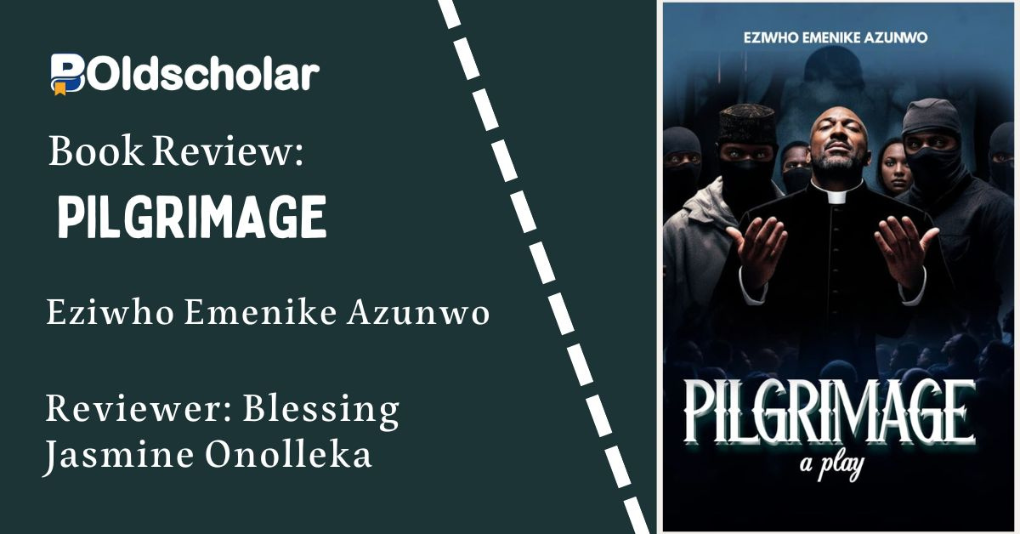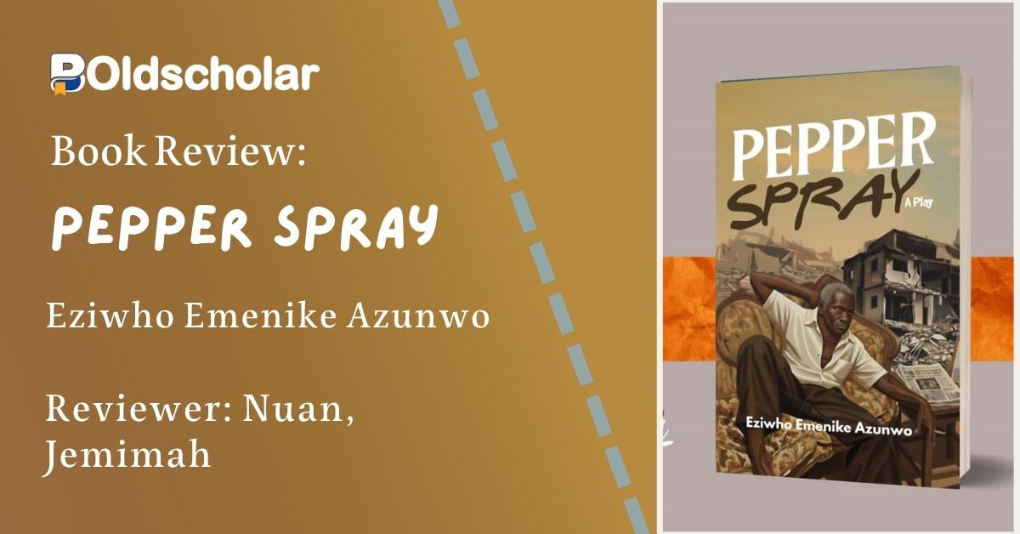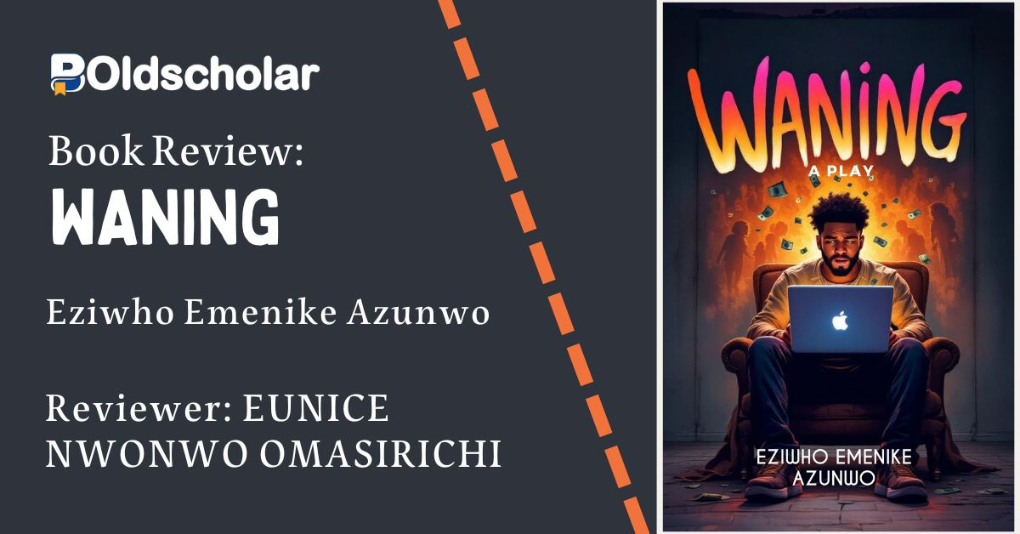At its core, the play dramatizes the abduction of a praying congregation by Agu Fire and his ruthless gang, exposing Nigeria’s kidnapping and ritual killing crisis. Through scenes of captivity, ransom negotiations, and eventual police intervention, the play interrogates faith under siege, the corruption of religion, and the human cost of insecurity. Pastor Owen’s sacrificial death becomes the tragic climax, while the rescue of survivors affirms resilience, justice, and the possibility of communal renewal.
Title – Pilgrimage
Genre – Drama
Author – Eziwho Emenike Azunwo
Reviewer – Blessing Jasmine Onolleka
Year of publication – 2025
Institution – Rivers State University Department – Theatre and Films Studies
Abstract
This paper critically reviews Pilgrimage, a play by Eziwho Emenike Azunwo, which dramatizes the realities of kidnapping, ritual killings, and the crisis of faith and justice in contemporary Nigerian society. The review explores the play’s plot, structure, character portrayals, thematic preoccupations, language, and style. It situates the work within the Nigerian dramatic tradition through comparative analysis with the plays of Wole Soyinka, Ola Rotimi, Femi Osofisan, Ahmed Yerima, and contemporary film. The review further evaluates the play’s strengths, limitations, and academic value, highlighting its relevance for Theatre for Development, African drama studies, and performance practice. It concludes that Pilgrimage is a socially conscious and theatrically effective work that contributes significantly to Nigerian dramatic literature.
Keywords: Nigerian drama, Pilgrimage, kidnapping, ritual killings, character analysis, Theatre for Development, realism, insecurity.
Introduction
Theatre in Africa has long been a mirror of society, a tool for social critique, and a catalyst for communal reflection. From Wole Soyinka’s ritualist explorations to Femi Osofisan’s revolutionary dramaturgy, Nigerian drama has consistently engaged with pressing social realities. Eziwho Emenike Azunwo’s Pilgrimage enters this tradition by dramatizing one of Nigeria’s most urgent crises: the scourge of kidnapping and ritual killings. Through a fusion of realism and symbolic performance, the play interrogates the fragility of faith, the abuse of religion, and the enduring struggle for justice in a society where violence often appears normalized.
Synopsis
Pilgrimage dramatizes the abduction of a congregation during a night of prayer led by Pastor Owen. The serenity of worship is shattered when Agu Fire, the dreaded gang leader, storms the altar with his men, declaring himself “the storm in the wilderness, the bitterness in the sky, the fear in the ocean.” The worshippers, trembling, are forced to acknowledge him as “Agu Fire!” The kidnappers demand thirty million naira as ransom. Pastor Owen pleads: “Please… they will pay whatever you want,” but Agu Fire silences him with the chilling warning: “If your family cannot pay thirty million by tomorrow, be ready to meet your maker. We will kill one person every hour until you are all dead.”
The community reels in fear. One elder laments, “Even the church is no longer safe!” while the DPO assures them that “everything is under control.” Relatives of Pastor Owen, Akan and Ruth, voice their anguish: “His pregnant wife and his five-year-old child have not seen him for days.” At a beer parlor, an undercover sting exposes the kidnappers’ network. A disguised gang member whispers to Akan, “I’m here for the money… act friendly.” The police intervention reveals the gang’s hideout. The climax unfolds at the ritual ground, where Agu Fire, surrounded by skulls and chanting followers, seizes Pastor Owen and declares: “Do not be afraid of those who kill the body but cannot kill the soul.” With terrifying solemnity, he sacrifices Owen, chanting: “For the blood of the lamb be slain on the lamp!” A police raid interrupts the ritual. Gunfire erupts, Agu Fire is killed, and captives are freed. A rescued woman weeps: “Thank you, officers… thank God!” ASP Mark, shaken, reflects: “The ugly side of reality lives among us… evil multiplies, often more than kindness. How do we fight back? By protecting, by saving, by refusing to give up.” The play closes with a prayer for victims: “May the souls of all kidnapped victims rest in peace.”
Character Analysis
Pastor Owen: He is a man of deep faith and moral conviction, whose personality radiates calmness, resilience, and sacrifice. In the play, his ability to endure suffering without losing hope reflects his strong spirituality. His ultimate death reinforces his role as a tragic hero and martyr, embodying the theme of faith tested by violence.
Agu Fire: As the central antagonist, Agu Fire’s personality is domineering, egocentric, and manipulative. He thrives on fear and intimidation, masking his insecurity through exaggerated self-styling and ritualistic displays. His charisma is darkly persuasive, enabling him to control his gang and captives alike. He represents how corrupt leadership weaponizes religion and fear to maintain power.
ASP Mark: Mark is drawn as a conflicted but empathetic figure. His personality is shaped by duty and vulnerability. Being a law officer, he is also a father and husband. His hesitation and moments of doubt make him a realistic character, representing the human face of state authority. By the end, his courage and reflection show growth, from fear to responsibility.
DPO (Divisional Police Officer): His personality is authoritative, disciplined, and reassuring. Unlike Mark, he exudes confidence and calm under pressure, embodying institutional stability. His role in guiding the community and directing the rescue shows him as a fatherly, stabilizing figure.
Akan and Ruth: Their personalities are rooted in care, compassion, and emotional vulnerability. They embody the human cost of abduction, showing the anguish of relatives caught between fear for loved ones and the practical impossibility of paying ransom.
Community Chief and Elders: Their personalities are cautious and reflective. They embody collective wisdom, yet they are also fearful, representing a society that relies heavily on tradition while depending on state security to survive crises.
Okoko and Gang Members: Their personalities reflect blind loyalty, opportunism, and moral weakness. They lack individuality, instead representing the faceless machinery of violence that sustains Agu Fire’s reign.
The Rescued Woman: Though a minor character, her personality is resilient and hopeful. Her survival signifies the endurance of ordinary people in the face of extraordinary violence.
Thematic Analysis
Kidnapping and Ritual Violence: Agu Fire’s chilling threat, “We will kill one person every hour until you are all dead,” captures the commodification of life. The altar with “ritual items and fetish paraphernalia” symbolizes greed and superstition.
Faith and Resilience: Pastor Owen clings to hope, while Agu Fire distorts scripture. Owen’s plea , “Please… they will pay whatever you want” against Agu Fire’s warning when he said “Be ready to meet your maker” this dramatizes faith under terror. Justice and Sacrifice: Owen’s death; “For the blood of the lamb be slain on the lamp!” contrasts with ASP Mark’s reflection: “Evil multiplies, often more than kindness.” Together, they highlight the painful price of justice.
Community Responsibility: Elders lament, “Even the church is no longer safe!” while the Chief insists: “The whole community relies on you, DPO.” This emphasizes communal solidarity. Abuse of Power and Corruption of Morality: Agu Fire compels captives to chant “Hallelujah” under duress, corrupting sacred words. His boastful self- styling reflects exploitation of fear. Hope and Renewal: The rescued woman’s cry “Thank you, officers… thank God!” and Mark’s words “By protecting, by saving, by refusing to give up” all affirm resilience.
Structure
Azunwo structures Pilgrimage into six distinct scenes, each functioning as a building block of suspense, conflict, and resolution. The structural rhythm alternates between three dominant spaces:
- The site of worship (captivity) – where the abduction and ritual scenes unfold.
- The community space (elders, relatives, and police meetings) – where fear, negotiation, and planning take place.
- The site of confrontation (beer parlor and hideout) – where the battle between justice and evil plays out.
This alternating structure creates a dramatic counterpoint: the chaos of captivity is set against the order of community deliberation, while the transitional beer parlor scene bridges the two worlds. The result is a sustained tension that mirrors the unpredictability of real-life insecurity.
The play also adopts a circular structure of faith and violence: it begins with prayer and ends with prayer. However, the opening prayer is disrupted by evil (Agu Fire’s entrance), while the closing prayer is one of mourning and resilience. This cyclical movement emphasizes the enduring presence of both faith and violence in Nigerian society.
Structurally, the play also employs ritual progression with drums, chants, and symbolic props marking transitions. These elements not only divide the play into acts of suspense but also create rhythm, echoing traditional African theatre where music and ritual drive the narrative forward.
Plot
The plot of Pilgrimage is both linear and tightly structured, progressing from abduction to climax and resolution. It mirrors a classical tragic arc while embedding Nigerian social realities.
- Exposition – The play begins with a community gathering for prayer, which establishes the peaceful atmosphere and introduces Pastor Owen as a spiritual leader. This calm setting is violently disrupted by Agu Fire and his gang, immediately launching the conflict.
- Rising Action – The captives’ ordeal deepens as ransom demands escalate, while the community and police strategize about possible rescue. The tension is heightened by emotional appeals from Owen’s relatives and the anxiety of the elders.
- Climax – The ritual sacrifice of Pastor Owen marks the emotional and symbolic peak of the play. This moment dramatizes the extremes of evil and the cost of faith.
- Falling Action – The police raid, the confrontation with the gang, and Agu
Fire’s death reverse the power balance.
- Resolution – The captives are freed, and the community reflects on both the loss and survival. This ending provides a bittersweet closure: justice is partially restored, but not without irreversible sacrifice.
The plot’s strength lies in its ability to combine realism (kidnapping, ransom negotiation, community fear) with symbolic depth (ritual altar, sacrificial death). This fusion makes the narrative socially relevant while theatrically powerful.
Language
Language in Pilgrimage is not only a medium of communication but also a tool of power, identity, and ideology. Azunwo skillfully layers different linguistic registers to reflect social hierarchies and thematic conflicts.
- Standard English – Used predominantly by the DPO, ASP Mark, the elders, and educated characters. It conveys authority, rationality, and order. Through English, the play reflects the institutional voice of the police and community leadership.
- Nigerian Pidgin – Used mainly by Agu Fire, his gang, and ordinary townsfolk. It grounds the play in Nigerian everyday reality, reflecting both accessibility and informality. Pidgin injects humor and sharpness but also symbolizes social marginality and rebellion.
- Religious and Biblical Language – This is where Azunwo achieves dramatic irony. Pastor Owen uses scripture for comfort and hope, while Agu Fire twists it into justification for violence. This dual usage reflects the wider Nigerian reality, where religion can be both a source of healing and a tool of manipulation.
- Proverbial and Poetic Expressions – The elders and Chief use proverbs to express fear and wisdom. For instance, figurative speech like likening insecurity to “a snake lifting its head from an empty pot” reflects indigenous philosophy and oral tradition.
The linguistic richness of the play reinforces its realism, grounds it in Nigerian culture, and dramatizes the tension between order and chaos, faith and corruption.
Style
The style of Pilgrimage is a hybrid of realism and ritual symbolism, a fusion that characterizes much of modern Nigerian drama.
- Realism: The realistic style emerges in the depiction of the kidnapping crisis, ransom negotiations, and the police raid. These are dramatizations of familiar Nigerian realities, giving the play immediacy and relevance.
Dialogue in English and Pidgin reflects authentic speech patterns, while characters such as the DPO and elders mirror real societal roles.
- Ritual and Symbolism: Ritual dominates the captivity scenes, especially the altar with skulls, chants, and sacrificial gestures. These symbols transcend realism, pulling the audience into a spiritual battlefield between good and evil. Agu Fire’s self-deification and his blending of scripture with incantations transform him into a ritual figure, both priest and executioner.
- Oral Performance Tradition: The play draws on African oral aesthetics: proverbs, repetition, and call-and-response patterns between Agu Fire and his gang. This gives dialogue rhythm and communal resonance.
- Use of Sound and Silence: Drums, flutes, and chants punctuate dramatic moments, enhancing atmosphere.
Silence is also used effectively, when captives tremble or hesitate, silence communicates fear more powerfully than words.
- Didactic Style: Like many protest and development plays, Pilgrimage has a didactic undertone. It is not merely entertainment but a moral and political statement. The clear moral polarity points Pastor Owen as good, Agu Fire as evil, it ensures the audience grasps the social message.
- Dramatic Irony: One of Azunwo’s key stylistic devices is irony: religious language becomes a tool of violence in Agu Fire’s mouth, while in Owen’s, it remains a symbol of hope. This contrast deepens the tragic tension of the play.
Comparative Dimensions
Azunwo’s Pilgrimage can be situated alongside notable Nigerian works:
Wole Soyinka’s The Road – both plays interrogate ritual violence and distorted spirituality.
Ola Rotimi’s Hopes of the Living Dead – both foreground faith and resilience amidst suffering.
Femi Osofisan’s Morountodun – both highlight communal responsibility and leadership.
Ahmed Yerima’s Hard Ground – both explore insecurity and social disintegration.
Contemporary film, The Black Book – shares themes of sacrifice and justice in confronting systemic violence.
Together, these comparisons establish Pilgrimage as part of a continuing Nigerian dramatic tradition that interrogates faith, power, and violence.
Critical Evaluation
The strengths of Pilgrimage include its topical relevance, effective suspense, symbolic richness, and integration of indigenous performance elements. Agu Fire is a memorable antagonist, and Pastor Owen a moving symbol of sacrificial faith. However, secondary characters could be more developed, and the resolution is somewhat abrupt, lacking extended reflection on communal healing. The stark moral dichotomy between good and evil, though effective for didactic clarity, risks oversimplifying the psychological complexity of criminality.
Nevertheless, the play succeeds in both social commentary and theatrical art. It dramatizes urgent national anxieties while reaffirming theatre’s role as a catalyst for awareness and transformation.
Recommendations
In light of its thematic urgency and stylistic depth, Pilgrimage is highly recommended for multiple audiences and purposes:
- For Performance: The play should be staged in universities, churches, community theatres, and cultural festivals. Its integration of drumming, ritual chants, and contemporary dialogue makes it both entertaining and thought- provoking. Performed live, it would provoke communal conversations about insecurity and moral responsibility.
- For Academic Study: The play is suitable for inclusion in curricula on African drama, Theatre for Development (TfD), and Performance Studies. Its realism, ritual elements, and linguistic hybridity make it a valuable case study in the intersection of literature and society.
- For Community Engagement: Beyond classrooms and theatres, Pilgrimage can be used as a sensitization tool by NGOs, religious organizations, and community groups to raise awareness about kidnapping, ritual killings, and the manipulation of religion for violence.
- For Further Research: Scholars can build on Azunwo’s work to examine contemporary Nigerian drama’s response to insecurity, comparing it with theatre traditions in other African contexts.
In summary, Pilgrimage is not only a literary text but also a social instrument. Its performance and study are strongly recommended as means of promoting awareness, dialogue, and resistance against violence in contemporary Nigerian society.
Conclusion
Eziwho Emenike Azunwo’s Pilgrimage is a significant addition to Nigerian drama. Through its exploration of kidnapping, ritual violence, faith, and justice, it mirrors the insecurities of contemporary society while affirming the power of resilience and communal solidarity. Structurally coherent, thematically rich, and stylistically compelling, the play demonstrates how theatre can confront uncomfortable realities and inspire reflection. Despite minor limitations in character development and resolution, Pilgrimage stands as a socially conscious work that contributes meaningfully to both Nigerian literature and academic discourse. It is recommended for performance, scholarly analysis, and use in Theatre for Development contexts.
Reference
Azunwo, E. E. (2025). “Pilgrimage” A play Covenant Daystar Publishers. Effiong, E. (Director). (2023). “The Black Book’ [Film]. Netflix.
Osofisan, F. (1982). “Morountodun and other plays”. Heinemann. Rotimi, O. (1988). “Hopes of the living dead”. Heinemann.
Soyinka, W. (1965). “The road”. Oxford University Press. Yerima, A. (2006). “Hard ground”. Kraft Books.
Share this post





Be the first to comment on this post